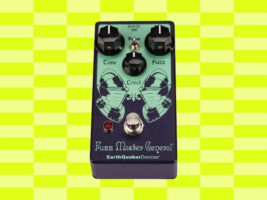
Earthquaker Devices Fuzz Master General review – “the full gamut of vintage-adjacent fuzz tones”
$179/£189, earthquakerdevices.com
What do you do when the ‘current climate’ makes things incredibly difficult for small US-based pedal brands to actually make ends meet? Akron’s own EarthQuaker Devices has been candid about the potentially devastating impact that current US economic policy is having on American builders like them. It all doubtless makes every new product launch even more of a risk – when the margins are smaller than ever and distribution is hampered by tariffs on all sides, making a new launch a success becomes ever harder.
READ MORE: EarthQuaker Devices Rancho de la Luna Dirt Transmitter review – heavy fuzz tones with a voltage-starving twist
Perhaps that’s why EQD has leaned into its Legacy Reissue programme in recent months? While the brand is still putting out new pedals, it’s notable that we’ve also seen them bring back some discontinued classics from the catalogue – the Dirt Transmitter in new clothes last month, and now a straight revival of a beloved octave fuzz in the shape of the Fuzz Master General.
Image: Press
Earthquaker Devices Fuzz Master General – what is it?
If you know anything about fuzz and the history of effects in general, you’ll be aware of the Univox Super-Fuzz – beloved of everyone from Pete Townshend to Kurt Cobain, it’s one of the proper foundational pedals in the history of guitar.
As is always the way with guitar however, it didn’t take long for rivals to start making their own copies and iterations on the form, and a notable early example of this is the Ace Tone FM-2 Fuzz Master, which first appeared in around 1967.
The FM-2 is a very similar circuit to the Super-Fuzz, and it’s this design that EQD based the original Fuzz Master General on back in 2015. There are of course some important differences between the FMG and its inspiration, designed to deliver a much broader range of octave-fuzz loveliness, as well as make it more suited to the needs of a modern guitar player.
Perhaps the most striking difference is a three-way toggle switch that selects between germanium, silicon and no diode clipping. In addition to the voice switch, the FMG dispenses with the tone switch of the original for a full variable tone control to add greater tonal flexibility, and you also get much more output and much lower noise than you would have in the original 60s unit.
Image: Press
Earthquaker Devices Fuzz Master General – sounds
With everything set to 12 o’clock and the voice switch sat in the middle third voice (yes for some reason the modes run 1-3-2 from left to right on the switch) and you could forgive yourself for ever assuming that this was any kind of vintage reissue. With no clipping to speak of here, there’s none of the buzzy, nasal-y sound that you might get with an old-school fuzz circuit, just lashings and lashing of brutal, devastating angular octave fuzz.
It still has something of that classic Super-Fuzz octave tonality however, it’s just presented in a much more forward, modern, band-centric fashion. There’s also a bit of a ‘hidden’ fourth mode here if you drop the fuzz control all the way down with no clipping, you get a clean octave sound that borders on a ring mod overtone – but a little more usable than that infinitely polarising effect.
Switching over to the first voice and the germanium clipping, and instantly this is more like the classic sound of a Super-Fuzz that I’d been expecting – it’s brash, cutting and a little nasal at times, especially when you push the knobs further to the left. A note of caution, while the tone knob here is really useful and allows you to really run the gamut of vintage fuzzy tones, the tightly compressed sound inherent to the circuit does mean you’ll likely want to have your fuzz up high to really cut through. All this means that when you nudge that tone control up to its higher reaches, feedback can be an issue – be warned before you attempt such a maneuver in a high-volume setting.
The germanium side is also much more responsive to picking dynamics and the setting of your guitar’s volume – it makes for a pretty wild ride all things considered, but it feels all the more authentic with it.
Switching over to the silicon mode, and it’s instantly a more forgiving experience, giving a more even response if you dig in – though we are dealing with an octave fuzz here, so it’s all relative in that regard. Chords can still sound pretty mushy and if you’re a bit haphazard with your picking it’ll certainly let you know about it. The distortion curve isn’t as smooth as on the germanium mode, but it gives a nice spread from mildly scuzzy to full-on wig-outs.
Earthquaker Devices Fuzz Master General – should I buy one?
Collectively, the three modes offer pretty much the full gamut of vintage-adjacent fuzz tones you could ask for in one pedal – it won’t veer off into the excesses of glitchy bit-crush-y wildness, but how often are most of us needing those sounds anyway? It’s such a versatile and well-rounded fuzz in fact, it’s a bit of a shame there isn’t an option to turn off the octave – while it sounds absolutely killer with them, it does somewhat limit the utility.
Ultimately, however, you can only judge this thing on what it is rather than what you want it to be. If you want a vintage octave fuzz with a greater spread of tones and a more reliable and consistent character than a vintage unit, this is pretty much everything you’d want in one. With just 1,600 units of this reissue being made however, you’d better act fast – it won’t be around for long.
Earthquaker Devices Fuzz Master General – alternatives
If you want a more eccentrically-authentic recreation of a different Super-Fuzz clone, then Warm Audio’s velvet-clad Foxy Tone Box ($149) is a wonderfully weird take on the Foxx Tone Machine. A personal favourite in the octave fuzz stakes is the Beetronics Vezzpa ($199) – which gives you thick, sputtery fuzz with the option of an octave up. Finally, Danelectro’s 3699 Fuzz ($199) is another Super-Fuzz-adjacent design that features footswitchable octave control.
The post Earthquaker Devices Fuzz Master General review – “the full gamut of vintage-adjacent fuzz tones” appeared first on Guitar.com | All Things Guitar.
Source: www.guitar-bass.net












